Aerial Drones for Geophysical Prospection in Mining: A Review
Abstract
1. Introduction
- What are the primary types of aerial drones used for geophysical surveys in the mining industry, and what are their key advantages and limitations?
- Which geophysical sensors have been specifically developed or adapted for aerial-drone-based surveys in mining, and what are their operational constraints?
- What geophysical methods based on aerial drones have been used in the past decade?
- What criteria should be considered when selecting the most suitable aerial drone platform for a specific geophysical survey in the mining sector, considering factors such as survey scale, terrain, and sensor integration?
- What are the current challenges and limitations in aerial-drone-based geophysical surveys for mining applications?
2. Research Methodology
- Magnetometry: TITLE-ABS-KEY. (“Drone” OR “UAV”) AND (“Magnetometer” OR “Magnetometry” OR “Magnetic”) AND (“Mining” OR “Mineral Exploration” OR “Resources Exploration” OR “Survey”).
- Ground-penetrating radar (GPR): TITLE-ABS-KEY (“Drone” OR “UAV”) AND (“Ground Penetrating Radar” OR “GPR” OR “Airborne GPR”) AND (“Mining” OR “Mineral Exploration” OR “Resources Exploration” OR “Survey”).
- Electromagnetics: TITLE-ABS-KEY (“Drone” OR “UAV”) AND (“Electromagnetic” OR “AEM” OR “EM”) AND (“Mining” OR “Mineral Exploration” OR “Resources Exploration” OR “Survey”).
- Gamma-ray spectrometry/radiometry: TITLE-ABS-KEY (“Drone” OR “UAV”) AND (“Gamma” OR “GRS” OR “Spectrometry”) AND (“Mining” OR “Mineral Exploration” OR “Resources Exploration” OR “Survey”).
- Gravimetry: TITLE-ABS-KEY (“Drone” OR “UAV”) AND (“Gravimetry” OR “Gravimeter”) AND (“Mining” OR “Mineral Exploration” OR “Resources Exploration” OR “Survey”)
- Seismic tomography: TITLE-ABS-KEY (“Drone” OR “UAV”) AND (“Seismic Refraction Tomography” OR “SRT” OR “Seismic Tomography”) AND (“Mining” OR “Mineral Exploration” OR “Resources Exploration” OR “Survey”).
- Electrical resistivity tomography: TITLE-ABS-KEY (“Drone” OR “UAV”) AND (“Electrical Resistivity” OR “ERT” OR “Electrical Resistivity Tomography”) AND (“Mining” OR “Mineral Exploration” OR “Resources Exploration” OR “Survey”).
3. Types of Aerial Drones Used in Geophysical Methods
3.1. Fixed-Wing Drones
3.2. Multirotors
3.3. Unmanned Helicopters
3.4. Hybrid Aerial Drones
3.5. Airships
4. Overview of Key Geophysical Methods Enhanced by Aerial Drones
4.1. Aerial Magnetometry
Data Processing of Aeromagnetic Data Surveys
4.2. Airborne Ground-Penetrating Radar (GPR)
Data Processing of Aerial GPR Surveys
4.3. Airborne Electromagnetic (AEM) Surveys
Data Processing of EM Surveys
4.4. Gamma-Ray Spectrometry (GRS)
Data Processing of Gamma-Ray Spectrometry Surveys
4.5. Other Geophysical Methods
5. Discussion
5.1. Types of Aerial Drones and Geophysical Methods Used in Mining Applications
5.2. Decision Criteria for Selecting Aerial Drones in Geophysical Surveys
5.3. Role of Aerial Geophysics According to the Phase of Mining Activity
5.4. Challenges and Limitations of Aerial-Drone-Based Geophysical Surveys
6. Conclusions
Author Contributions
Funding
Data Availability Statement
Conflicts of Interest
References
- Hustrulid, W.A.; Kuchta, M.; Martin, R.K. Open Pit Mine Planning and Design, Two Volume Set & CD-Rom Pack; CRC Press: Boca Raton, FL, USA, 2013. [Google Scholar] [CrossRef]
- Moezzi, R.; Kamkar-Rouhani, A.; Arab-Amiri, A.R. Development of Drone-Borne Geophysical Surveys for Mineral Exploration. J. Environ. Sustain. Min. 2024, 2, 40–46. [Google Scholar] [CrossRef]
- Okada, K. Breakthrough technologies for mineral exploration. Miner. Econ. 2022, 35, 429–454. [Google Scholar] [CrossRef]
- Park, S.; Choi, Y. Applications of Unmanned Aerial Vehicles in Mining from Exploration to Reclamation: A Review. Minerals 2020, 10, 663. [Google Scholar] [CrossRef]
- Mollehuara-Canales, R.; Kozlovskaya, E.; Lunkka, J.; Moisio, K.; Pedretti, D. Non-invasive geophysical imaging and facies analysis in mining tailings. J. Appl. Geophys. 2021, 192, 104402. [Google Scholar] [CrossRef]
- Cara, S.; Fais, S.; Ligas, P.; Matzuzzi, C.; Podda, F. Integrated Geological-Geophysical and UAS Proximal Sensing Approach to the Study of Ground Water Movement Between Two Open-Pit Pools in an Abandoned Mine Area. In Proceedings of the EGU General Assembly 2021, Virtual, 19–30 April 2021. [Google Scholar] [CrossRef]
- Becker, A.M.; Becker, R.H.; Doro, K.O. Locating Drainage Tiles at a Wetland Restoration Site within the Oak Openings Region of Ohio, United States Using UAV and Land Based Geophysical Techniques. Res. Sq. 2021, preprint. [Google Scholar] [CrossRef]
- Page, M.J.; McKenzie, J.E.; Bossuyt, P.M.; Boutron, I.; Hoffmann, T.C.; Mulrow, C.D.; Shamseer, L.; Tetzlaff, J.M.; Akl, E.A.; Brennan, S.E.; et al. The Prisma 2020 statement: An updated guideline for reporting systematic reviews. BMJ 2021, 372, n71. [Google Scholar] [CrossRef]
- D’Alessandro, A.; Bucalo, F.; Coltelli, M.; Martorana, R. Drones—New technologies for geophysics? In Proceedings of the Near Surface Geoscience 2015—21st European Meeting of Environmental and Engineering Geophysics, Turin, Italy, 6–10 September 2015. [Google Scholar] [CrossRef]
- Haque, A.; Chowdhury, M.N.-U.-R.; Hassanalian, M. A Comprehensive Review of Classification and Application of Machine Learning in Drone Technology. Preprints 2023, 2023061901. [Google Scholar] [CrossRef]
- Telli, K.; Kraa, O.; Himeur, Y.; Ouamane, A.; Boumehraz, M.; Atalla, S.; Mansoor, W. A Comprehensive Review of Recent Research Trends on Unmanned Aerial Vehicles (UAVs). Systems 2023, 11, 400. [Google Scholar] [CrossRef]
- Giordan, D.; Adams, M.S.; Aicardi, I.; Alicandro, M.; Allasia, P.; Baldo, M.; De Berardinis, P.; Dominici, D.; Godone, D.; Hobbs, P.; et al. The use of unmanned aerial vehicles (UAVs) for engineering geology applications. Bull. Eng. Geol. Environ. 2020, 79, 3437–3481. [Google Scholar] [CrossRef]
- Al-Lqubaydhi, N.; Alenezi, A.; Alanazi, T.; Senyor, A.; Alanezi, N.; Alotaibi, B.; Alotaibi, M.; Razaque, A.; Hariri, S. Deep Learning for Unmanned Aerial Vehicles Detection: A Review. Comput. Sci. Rev. 2024, 51, 100614. [Google Scholar] [CrossRef]
- Woodbridge, E.; Connor, D.T.; Verbelen, Y.; Hine, D.; Richardson, T.; Scott, T.B. Airborne gamma-ray mapping using fixed-wing vertical take-off and landing (VTOL) uncrewed aerial vehicles. Front. Robot. AI 2023, 10, 1137763. [Google Scholar] [CrossRef] [PubMed]
- Nikulin, A.; de Smet, T.S. A UAV-based magnetic survey method to detect and identify orphaned oil and Gas Wells. Lead. Edge 2019, 38, 447–452. [Google Scholar] [CrossRef]
- Saponaro, A.; Dipierro, G.; Cannella, E.; Panarese, A.; Galiano, A.M.; Massaro, A. A UAV-GPR Fusion Approach for the Characterization of a Quarry Excavation Area in Falconara Albanese, Southern Italy. Drones 2021, 5, 40. [Google Scholar] [CrossRef]
- Van Der Veeke, S.; Koomans, R.L.; van Egmond, F.M.; Limburg, J. A drone as platform for airborne gamma-ray surveys to characterize soil and monitor contaminations. In Proceedings of the 24th European Meeting of Environmental and Engineering Geophysics, Porto, Portugal, 9–12 September 2018; pp. 1–5. [Google Scholar] [CrossRef]
- Limburg, H.; van der Veeke, S.; Koomans, R. Towards drone-borne gammaray mapping of Soils. First Break 2019, 37, 55–61. [Google Scholar] [CrossRef]
- Lu, N.; Xi, Y.; Zheng, H.; Gao, W.; Li, Y.; Liu, Y.; Cui, Z.; Liao, G.; Liu, J. Development of a Hybrid Fixed-Wing UAV Aeromagnetic Survey System and an Application Study in Chating Deposit. Minerals 2023, 13, 1094. [Google Scholar] [CrossRef]
- Kim, B.; Lee, S.; Park, G.; Cho, S.J. Development of an unmanned airship for magnetic exploration. Explor. Geophys. 2020, 52, 462–467. [Google Scholar] [CrossRef]
- Radoglou-Grammatikis, P.; Sarigiannidis, P.; Lagkas, T.; Moscholios, I. A compilation of UAV applications for Precision Agriculture. Comput. Netw. 2020, 172, 107148. [Google Scholar] [CrossRef]
- Pal, O.K.; Shovon, M.S.; Mridha, M.F.; Shin, J. A Comprehensive Review of AI-enabled Unmanned Aerial Vehicle: Trends, Vision, and Challenges. arXiv 2023, arXiv:2310.16360. [Google Scholar] [CrossRef]
- Darvishpoor, S.; Roshanian, J.; Raissi, A.; Hassanalian, M. Configurations, flight mechanisms, and applications of unmanned aerial systems: A Review. Prog. Aerosp. Sci. 2020, 121, 100694. [Google Scholar] [CrossRef]
- Watts, A.C.; Ambrosia, V.G.; Hinkley, E.A. Unmanned Aircraft Systems in Remote Sensing and Scientific Research: Classification and Considerations of Use. Remote Sens. 2012, 4, 1671–1692. [Google Scholar] [CrossRef]
- Lee, S.; Choi, Y. Reviews of Unmanned Aerial Vehicle (drone) technology trends and its applications in the mining industry. Geosystem Eng. 2016, 19, 197–204. [Google Scholar] [CrossRef]
- Ye, L.; Yu, Z.; Zhang, Y.; Chi, C.; Cheng, P.; Chen, J. An Aeromagnetic Compensation Strategy for Large UAVs. Sensors 2024, 24, 3775. [Google Scholar] [CrossRef] [PubMed]
- Accomando, F.; Bonfante, A.; Buonanno, M.; Natale, J.; Vitale, S.; Florio, G. The drone-borne magnetic survey as the optimal strategy for high-resolution investigations in presence of extremely rough terrains: The case study of the taverna san felice quarry dike. J. Appl. Geophys. 2023, 217, 105186. [Google Scholar] [CrossRef]
- Bian, J.; Wang, X.; Gao, S. Experimental aeromagnetic survey using a rotary-wing aircraft system: A case study in Heizhugou, Sichuan, China. J. Appl. Geophys. 2021, 184, 104245. [Google Scholar] [CrossRef]
- Phelps, G.; Bracken, R.; Spritzer, J.; White, D. Achieving sub-nanotesla precision in multirotor UAV aeromagnetic surveys. J. Appl. Geophys. 2022, 206, 104779. [Google Scholar] [CrossRef]
- Li, Y.; Han, Q.; Peng, X.; Li, Q.; Tong, X. A Magnetic Interference Compensation Method for Airborne Electronic Equipment without Current Sensors. Remote Sens. 2022, 14, 4151. [Google Scholar] [CrossRef]
- Zheng, Y.; Li, S.; Xing, K.; Zhang, X. Unmanned Aerial Vehicles for Magnetic Surveys: A Review on Platform Selection and Interference Suppression. Drones 2021, 5, 93. [Google Scholar] [CrossRef]
- Accomando, F.; Vitale, A.; Bonfante, A.; Buonanno, M.; Florio, G. Performance of Two Different Flight Configurations for Drone-Borne Magnetic Data. Sensors 2021, 21, 5736. [Google Scholar] [CrossRef]
- Zhou, S.; Yang, C.; Su, Z.; Yu, P.; Jiao, J. An Aeromagnetic Compensation Algorithm Based on Radial Basis Function Artificial Neural Network. Appl. Sci. 2023, 13, 136. [Google Scholar] [CrossRef]
- Tolles, W.; Lawson, J. Magnetic Compensation of MAD Equipped Aircraft; Airborne Instruments Lab. Inc.: Mineola, NY, USA, 1950; p. 201. [Google Scholar]
- Jackisch, R.; Madriz, Y.; Zimmermann, R.; Pirttijärvi, M.; Saartenoja, A.; Heincke, B.H.; Salmirinne, H.; Kujasalo, J.-P.; Andreani, L.; Gloaguen, R. Drone-Borne Hyperspectral and Magnetic Data Integration: Otanmäki Fe-Ti-V Deposit in Finland. Remote Sens. 2019, 11, 2084. [Google Scholar] [CrossRef]
- Stoll, J.; Moritz, D. Unmanned aircraft systems for rapid near Surface Geophysical Measurements. In Proceedings of the 75th EAGE Conference & Exhibition—Workshops, London, UK, 10–13 June 2013. [Google Scholar] [CrossRef]
- Macharet, D.; Perez-Imaz, H.; Rezeck, P.; Potje, G.; Benyosef, L.; Wiermann, A.; Freitas, G.; Garcia, L.; Campos, M. Autonomous Aeromagnetic Surveys using a fluxgate magnetometer. Sensors 2016, 16, 2169. [Google Scholar] [CrossRef] [PubMed]
- Malehmir, A.; Dynesius, L.; Paulusson, K.; Paulusson, A.; Johansson, H.; Bastani, M.; Wedmark, M.; Marsden, P. The potential of rotary-wing UAV-based magnetic surveys for mineral exploration: A case study from Central Sweden. Lead. Edge 2017, 36, 552–557. [Google Scholar] [CrossRef]
- Cunningham, M.; Samson, C.; Wood, A.; Cook, I. Aeromagnetic surveying with a rotary-wing unmanned aircraft system: A case study from a zinc deposit in Nash Creek, New Brunswick, Canada. Pure Appl. Geophys. 2017, 175, 3145–3158. [Google Scholar] [CrossRef]
- Parshin, A.V.; Morozov, V.A.; Blinov, A.V.; Kosterev, A.N.; Budyak, A.E. Low-altitude geophysical magnetic prospecting based on multirotor UAV as a promising replacement for Traditional Ground Survey. Geo-Spat. Inf. Sci. 2018, 21, 67–74. [Google Scholar] [CrossRef]
- Cunningham, M.; Samson, C.; Laliberté, J.; Goldie, M.; Wood, A.; Birkett, D. Inversion of magnetic data acquired with a rotary-wing unmanned aircraft system for gold exploration. Pure Appl. Geophys. 2021, 178, 501–516. [Google Scholar] [CrossRef]
- Kim, B.; Jeong, S.; Bang, E.; Shin, S.; Cho, S. Investigation of iron ore mineral distribution using aero-magnetic exploration techniques: Case study at Pocheon, Korea. Minerals 2021, 11, 665. [Google Scholar] [CrossRef]
- Shahsavani, H. An aeromagnetic survey carried out using a rotary-wing UAV equipped with a low-cost magneto-inductive sensor. Int. J. Remote Sens. 2021, 42, 8805–8818. [Google Scholar] [CrossRef]
- Porras, D.; Carrasco, J.; Carrasco, P.; Alfageme, S.; Gonzalez-Aguilera, D.; Lopez Guijarro, R. Drone Magnetometry in Mining Research. An Application in the Study of Triassic Cu–Co–Ni Mineralizations in the Estancias Mountain Range, Almería (Spain). Drones 2021, 5, 151. [Google Scholar] [CrossRef]
- Walter, C.; Braun, A.; Fotopoulos, G. High-Resolution Unmanned Aerial Vehicle Aeromagnetic surveys for mineral exploration targets. Geophys. Prospect. 2019, 68, 334–349. [Google Scholar] [CrossRef]
- Parvar, K.; Braun, A.; Layton-Matthews, D.; Burns, M. UAV magnetometry for chromite exploration in the Samail ophiolite sequence, Oman. J. Unmanned Veh. Syst. 2017, 6, 57–69. [Google Scholar] [CrossRef]
- de Smet, T.S.; Nikulin, A.; Romanzo, N.; Graber, N.; Dietrich, C.; Puliaiev, A. Successful application of drone-based aeromagnetic surveys to locate legacy oil and Gas Wells in Cattaraugus County, New York. J. Appl. Geophys. 2021, 186, 104250. [Google Scholar] [CrossRef]
- Liu, J.; Liu, H.; Liu, R.; Xue, J.; Li, Y.; Wang, F. Application of aeromagnetic survey to mineral exploration of Jinping, Yunnan, China by using Multirotor UAV. Trans. Nonferrous Met. Soc. China 2023, 33, 1550–1558. [Google Scholar] [CrossRef]
- Shahsavani, H.; Smith, R.S. Aeromagnetic gradiometry with UAV, a case study on small iron ore deposit. Drone Syst. Appl. 2024, 12, 1–9. [Google Scholar] [CrossRef]
- Døssing, A.; Lima Simoes da Silva, E.; Martelet, G.; Maack Rasmussen, T.; Gloaguen, E.; Thejll Petersen, J.; Linde, J. A High-Speed, Light-Weight Scalar Magnetometer Bird for km Scale UAV Magnetic Surveying: On Sensor Choice, Bird Design, and Quality of Output Data. Remote Sens. 2021, 13, 649. [Google Scholar] [CrossRef]
- Martelet, G.; Gloaguen, E.; Døssing, A.; Lima Simoes da Silva, E.; Linde, J.; Rasmussen, T.M. Airborne/UAV Multisensor Surveys Enhance the Geological Mapping and 3D Model of a Pseudo-Skarn Deposit in Ploumanac’h, French Brittany. Minerals 2021, 11, 1259. [Google Scholar] [CrossRef]
- García, J.C.; García, P.C.; Sanchiz, D.P.; Nieto, I.M.; Blázquez, C.S.; Hurtado, P.H. Drone Magnetic and Time Domain Electromagnetic Exploration in Metamorphic Formations: Tool for the Identification of Strategic Sites for Aquifer Exploitation. Appl. Sci. 2023, 13, 10949. [Google Scholar] [CrossRef]
- Cao, W.; Qing, H.; Xu, X.; Liu, C.; Chen, S.; Zhong, Y.; Liu, J.; Li, Y.; Jiang, X.; Gao, D.; et al. Pre-Archaeological Investigation by Integrating Unmanned Aerial Vehicle Aeromagnetic Surveys and Soil Analyses. Drones 2022, 6, 243. [Google Scholar] [CrossRef]
- Schmidt, V.; Coolen, J.; Fritsch, T.; Klingen, S. Towards drone-based magnetometer measurements for archaeological prospection in challenging terrain. Drone Syst. Appl. 2024, 12, 1–15. [Google Scholar] [CrossRef]
- Perikleous, D.; Margariti, K.; Velanas, P.; Blazquez, C.S.; Garcia, P.C.; Gonzalez-Aguilera, D. Application of Magnetometer-Equipped Drone for Mineral Exploration in Mining Operations. Drones 2025, 9, 24. [Google Scholar] [CrossRef]
- Frey, M.; Bossennec, C.; Sass, I. Mapping buried fault zones in a granitic pluton using aeromagnetic data. Pure Appl. Geophys. 2023, 180, 2241–2255. [Google Scholar] [CrossRef]
- Smit, J.P.; Stettler, E.H.; Price, A.B.; Schaefer, M.O.; Schodlok, M.C.; Zhang, R. Use of drones in acquiring B-field total-field electromagnetic data for Mineral Exploration. Miner. Econ. 2022, 35, 455–465. [Google Scholar] [CrossRef]
- Ugalde, H.; Morris, W.; Madriz, Y.; Kirsch, M.; Gloaguen, R.; Schneider, M.; Schiffler, M.; Siemon, B.; Fréville, T.; Munschy, M. Locating skarns with magnetic survey data, Geyer, erzgebirge: Optimizing Data Acquisition Procedures. Geophys. Prospect. 2022, 70, 1273–1292. [Google Scholar] [CrossRef]
- Cunningham, M.; Samson, C.; Laliberté, J.; Goldie, M.; Wood, A.; Birkett, D. Comparison between ground, helicopter, and unmanned aircraft system magnetic datasets: A case study from the Abitibi Greenstone Belt, Canada. Pure Appl. Geophys. 2022, 179, 1871–1886. [Google Scholar] [CrossRef]
- Parshin, A.; Gatilov, M.; Davidenko, Y.; Bashkeev, A.; Snegirev, N.; Milgunov, A. Using the “Triad” of UAV-TEM, UAV-magnetic prospecting and UAV-gamma-spectrometry: Case of prospecting for blind ore deposits. In Proceedings of the NSG2022 3rd Conference on Airborne, Drone and Robotic Geophysics, Belgrade Serbia, 18–22 September 2022; pp. 1–5. [Google Scholar] [CrossRef]
- Movchan, I.; Shaygallyamova, Z.; Yakovleva, A. Identification of structural control factors of primary gold ore occurrences by method of unmanned aeromagnetic survey by the example of the Neryungrisky district of Yakutia. J. Min. Inst. 2022, 254, 217–233. [Google Scholar] [CrossRef]
- Parshin, A.; Budyak, A.; Chebokchinov, I.; Sapunov, V.; Bulnayev, A.; Morozov, V. Complex UAS-geophysical surveys at the first stages of geological prospecting: Case in the Western Sayan (Russia). In Proceedings of the First EAGE Workshop on Unmanned Aerial Vehicles, Toulouse, France, 2–4 December 2019; pp. 1–5. [Google Scholar] [CrossRef]
- Parshin, A.; Morozov, V.; Grebenkin, N.; Sapunov, V.; Shikalenko, F.; Rzhevskaya, A. “Quasi-terrestrial” UAV-based geophysical methods: Efficiency and role in geological prospecting. In Proceedings of the Engineering and Mining Geophysics 2018—14th Conference and Exhibition, Almaty, Kazakhstan, 23–27 April 2018. [Google Scholar] [CrossRef]
- Li, W.J.; Qin, X.W.; Gan, X.P. The IGGE UAV aero magnetic and radiometric survey system. In Proceedings of the Near Surface Geoscience 2014—20th European Meeting of Environmental and Engineering Geophysics, Athens, Greece, 14–18 September 2014. [Google Scholar] [CrossRef]
- Anderson, D.; Pita, A. Geophysical surveying with Georanger UAV. In Proceedings of the Infotech@Aerospace, Arlington, VA, USA, 26–29 September 2005. [Google Scholar] [CrossRef]
- Jackisch, R.; Lorenz, S.; Kirsch, M.; Zimmermann, R.; Tusa, L.; Pirttijärvi, M.; Saartenoja, A.; Ugalde, H.; Madriz, Y.; Savolainen, M.; et al. Integrated geological and geophysical mapping of a carbonatite-hosting outcrop in Siilinjärvi, Finland, using unmanned aerial systems. Remote Sens. 2020, 12, 2998. [Google Scholar] [CrossRef]
- Xi, Y.-Z.; Liao, G.-X.; Lu, N.; Li, Y.-B.; Wu, S. Study on the Aeromagnetic System between Fixed-Wing UAV and Unmanned Helicopter. Minerals 2023, 13, 700. [Google Scholar] [CrossRef]
- Jackisch, R.; Heincke, B.H.; Zimmermann, R.; Sørensen, E.V.; Pirttijärvi, M.; Kirsch, M.; Salmirinne, H.; Lode, S.; Kuronen, U.; Gloaguen, R. Drone-based magnetic and multispectral surveys to develop a 3D model for mineral exploration at Qullissat, Disko Island, Greenland. Solid Earth 2022, 13, 793–825. [Google Scholar] [CrossRef]
- Jiang, D.; Zeng, Z.; Zhou, S.; Guan, Y.; Lin, T. Integration of an aeromagnetic measurement system based on an unmanned aerial vehicle platform and its application in the exploration of the ma’anshan magnetite deposit. IEEE Access 2020, 8, 189576–189586. [Google Scholar] [CrossRef]
- Huang, J.-P.; Guo, H.; Han, S.; Huang, Y. Development and application of an aeromagnetic survey system for a large load rotary-wing UAV. Appl. Geophys. 2023, 20. [Google Scholar] [CrossRef]
- Luyendyk, A.P.J. Processing of Airborne Magnetic Data. AGSO J. Aust. Geol. Geophys. 1997, 17, 31–38. [Google Scholar]
- Frid, M.; Frid, V. Vital Views into Drone-Based GPR Application: Precise Mapping of Soil-to-Rock Boundaries and Ground Water Level for Foundation Engineering and Site-Specific Response. Appl. Sci. 2024, 14, 7889. [Google Scholar] [CrossRef]
- Rezaei, A.; Hassani, H.; Moarefvand, P.; Golmohammadi, A. Determination of unstable tectonic zones in C–North deposit, Sangan, NE Iran using GPR method: Importance of structural geology. J. Min. Environ. 2019, 10, 177–195. [Google Scholar] [CrossRef]
- Lombardi, F.; Podd, F.; Solla, M. From Its Core to the Niche: Insights from GPR Applications. Remote Sens. 2022, 14, 3033. [Google Scholar] [CrossRef]
- López, Y.Á.; García-Fernández, M.; Álvarez-Narciandi, G.; Andrés, F.L.-H. Unmanned aerial vehicle-based ground-penetrating radar systems: A Review. IEEE Geosci. Remote Sens. Mag. 2022, 10, 66–86. [Google Scholar] [CrossRef]
- Sun, H.; Zhang, N.; Li, D.; Liu, S.; Ye, Q. The first semi-airborne transient electromagnetic survey for tunnel investigation in very complex terrain areas. Tunn. Undergr. Space Technol. 2023, 132, 104893. [Google Scholar] [CrossRef]
- Prikhodko, A.; Bagrianski, A.; Kuzmin, P. Airborne Natural Total Field Broadband Electromagnetics—Configurations, Capabilities, and Advantages. Minerals 2024, 14, 704. [Google Scholar] [CrossRef]
- Harrison, E.J.; Baranwal, V.C.; Pfaffhuber, A.A.; Christensen, C.W.; Skurdal, G.H.; Rønning, J.S.; Anschütz, H.; Brönner, M. AEM in Norway: A Review of the Coverage, Applications and the State of Technology. Remote Sens. 2021, 13, 4687. [Google Scholar] [CrossRef]
- Wu, X.; Xue, G.; Fang, G.; Li, X.; Ji, Y. The development and applications of the semi-airborne electromagnetic system in China. IEEE Access 2019, 7, 104956–104966. [Google Scholar] [CrossRef]
- Wu, J.; Xiao, D.; Du, B.; Liu, Y.; Zhi, Q.; Wang, X.; Deng, X.; Chen, X.; Zhao, Y.; Huang, Y. Exploring Shallow Geological Structures in Landslides Using the Semi-Airborne Transient Electromagnetic Method. Remote Sens. 2024, 16, 3186. [Google Scholar] [CrossRef]
- Parshin, A.; Bashkeev, A.; Davidenko, Y.; Persova, M.; Iakovlev, S.; Bukhalov, S.; Grebenkin, N.; Tokareva, M. Lightweight Unmanned Aerial System for Time-Domain Electromagnetic Prospecting—The Next Stage in Applied UAV-Geophysics. Appl. Sci. 2021, 11, 2060. [Google Scholar] [CrossRef]
- Hallbauer-Zadorozhnaya, V.D.; Yu, A.; Parshin, A.V.; Stettler, E. Drone based experimental TEM surveys over Lake Baikal and a uranium occurrence. In Proceedings of the 25th EM Induction Workshop, Çeşme, Turkey, 11–17 September 2022. [Google Scholar]
- Davidenko, Y.; Hallbauer-Zadorozhnaya, V.; Bashkeev, A.; Parshin, A. Semi-Airborne UAV-TEM System Data Inversion with S-Plane Method—Case Study over Lake Baikal. Remote Sens. 2023, 15, 5310. [Google Scholar] [CrossRef]
- Success Story 12/2024—First Successful Drone Electromagnetic Survey. Dronesom. Available online: https://dronesom.com/success-story-12-2024-first-successful-drone-electromagnetic-survey/ (accessed on 7 January 2025).
- Siemon, B.; Christiansen, A.V.; Auken, E. A review of helicopter-borne electromagnetic methods for groundwater exploration. Near Surf. Geophys. 2009, 7, 629–646. [Google Scholar] [CrossRef]
- Parshin, A.; Morozov, V.; Snegirev, N.; Valkova, E.; Shikalenko, F. Advantages of Gamma-Radiometric and Spectrometric Low-Altitude Geophysical Surveys by Unmanned Aerial Systems with Small Scintillation Detectors. Appl. Sci. 2021, 11, 2247. [Google Scholar] [CrossRef]
- Kunze, C.; Preugschat, B.; Arndt, R.; Kandzia, F.; Wiens, B.; Altfelder, S. Development of a UAV-Based Gamma Spectrometry System for Natural Radionuclides and Field Tests at Central Asian Uranium Legacy Sites. Remote Sens. 2022, 14, 2147. [Google Scholar] [CrossRef]
- Li, J.; Zhang, W.; Wu, X.; Wu, X.; Wei, B.; Wu, L.; Li, Y.; Wang, P. Design and application of γ-Ray Energy Spectrum Survey System based on UAV. In PBNC 2022, Proceedings of the 23rd Pacific Basin Nuclear Conference, Beijing, China, 1–4 November 2022; Springer Proceedings in Physics; Springer: Singapore, 2023; pp. 581–588. [Google Scholar] [CrossRef]
- Preugschat, B.; Kunze, C.; Wiens, B.; Altfelder, S. Drone-based investigations of uranium mining legacies: An airborne gamma spectrometry method to support, INSPECT, and monitor mine closure processes. In Proceedings of the International Conference on Mine Closure, Brisbane, Australia, 4–6 October 2022; pp. 623–632. [Google Scholar] [CrossRef]
- Martin, P.G.; Payton, O.D.; Fardoulis, J.S.; Richards, D.A.; Scott, T.B. The use of unmanned aerial systems for the mapping of Legacy Uranium Mines. J. Environ. Radioact. 2015, 143, 135–140. [Google Scholar] [CrossRef]
- Šálek, O.; Matolín, M.; Gryc, L. Mapping of radiation anomalies using UAV mini-airborne gamma-ray spectrometry. J. Environ. Radioact. 2018, 182, 101–107. [Google Scholar] [CrossRef] [PubMed]
- Altfelder, S.; Preugschat, B.; Matos, M.; Kandzia, F.; Wiens, B.; Eshmuradov, O.; Kunze, C. Upscaling ground-based backpack gamma-ray spectrometry to spatial resolution of UAV-based gamma-ray spectrometry for system validation. J. Environ. Radioact. 2024, 273, 107382. [Google Scholar] [CrossRef]
- Parshin, A.V.; Budyak, A.E.; Babyak, V.N. Interpretation of integrated aerial geophysical surveys by unmanned aerial vehicles in mining: A case of additional flank exploration. IOP Conf. Ser. Earth Environ. Sci. 2020, 459, 052079. [Google Scholar] [CrossRef]
- Martin, P.G.; Connor, D.T.; Estrada, N.; El-Turke, A.; Megson-Smith, D.; Jones, C.P.; Kreamer, D.K.; Scott, T.B. Radiological Identification of Near-Surface Mineralogical Deposits Using Low-Altitude Unmanned Aerial Vehicle. Remote Sens. 2020, 12, 3562. [Google Scholar] [CrossRef]
- Deng, Z.; Ge, L.; Wen, L.; Guo, S.; Tang, C.; Yu, P.; Chen, Z. Height and terrain correction of UAV radioactive measurements based on DEM Data. J. Environ. Radioact. 2025, 285, 107655. [Google Scholar] [CrossRef]
- Xia, J.; Song, B.; Gu, Y.; Li, Z.; Xu, J.; Ge, L.; Zhang, Q.; Zeng, G.; Liu, Q.; Yang, X. Application of advanced spectral-ratio radon background correction in the UAV-borne gamma-ray spectrometry. Nucl. Eng. Technol. 2023, 55, 2927–2934. [Google Scholar] [CrossRef]
- Hopfner, M.; Brönner, M.; Carter, L.; Nazari-Dehkordi, T.; Menuge, J.; Müller, A.; Williamson, B. Vectoring towards buried high-purity quartz metapegmatites using low-elevation radiometric and soil geochemical surveying: Method validation in Tysfjord, Norway. J. Geochem. Explor. 2025, 270, 107667. [Google Scholar] [CrossRef]
- Erdi-Krausz, G.; Matolin, M.; Minty, B.; Nicolet, J.P.; Reford, W.S.; Schetselaar, E.M. Guidelines for Radioelement Mapping Using Gamma Ray Spectrometry Data; IAEA-TECDOC; International Atomic Energy Agency (IAEA): Vienna, Austria, 2003; Volume 1363, Available online: http://www-pub.iaea.org/MTCD/publications/PDF/te_1363_web.pdf (accessed on 14 April 2025).
- Benson, A. Seismic Tomography: EBSCO. EBSCO Information Services, Inc. 2022. Available online: https://www.ebsco.com/research-starters/earth-and-atmospheric-sciences/seismic-tomography#seismic-surveys (accessed on 14 April 2025).
- Delmonte, N.; Spaggiari, D.; Chiorboli, G.; Fagandini, C.; Zanini, A. An electrical resistivity tomography system for imaging at Laboratory Scale. Measurement 2025, 252, 117366. [Google Scholar] [CrossRef]
- Geophysical Methods. CLU. Available online: https://clu-in.org/characterization/technologies/default2.focus/sec/Geophysical_Methods/cat/Gravity_Methods/ (accessed on 14 April 2025).
- Troccoli, E.B.; Cerqueira, A.G.; Lemos, J.B.; Holz, M. K-means clustering using principal component analysis to Automate label organization in multi-attribute seismic facies analysis. J. Appl. Geophys. 2022, 198, 104555. [Google Scholar] [CrossRef]
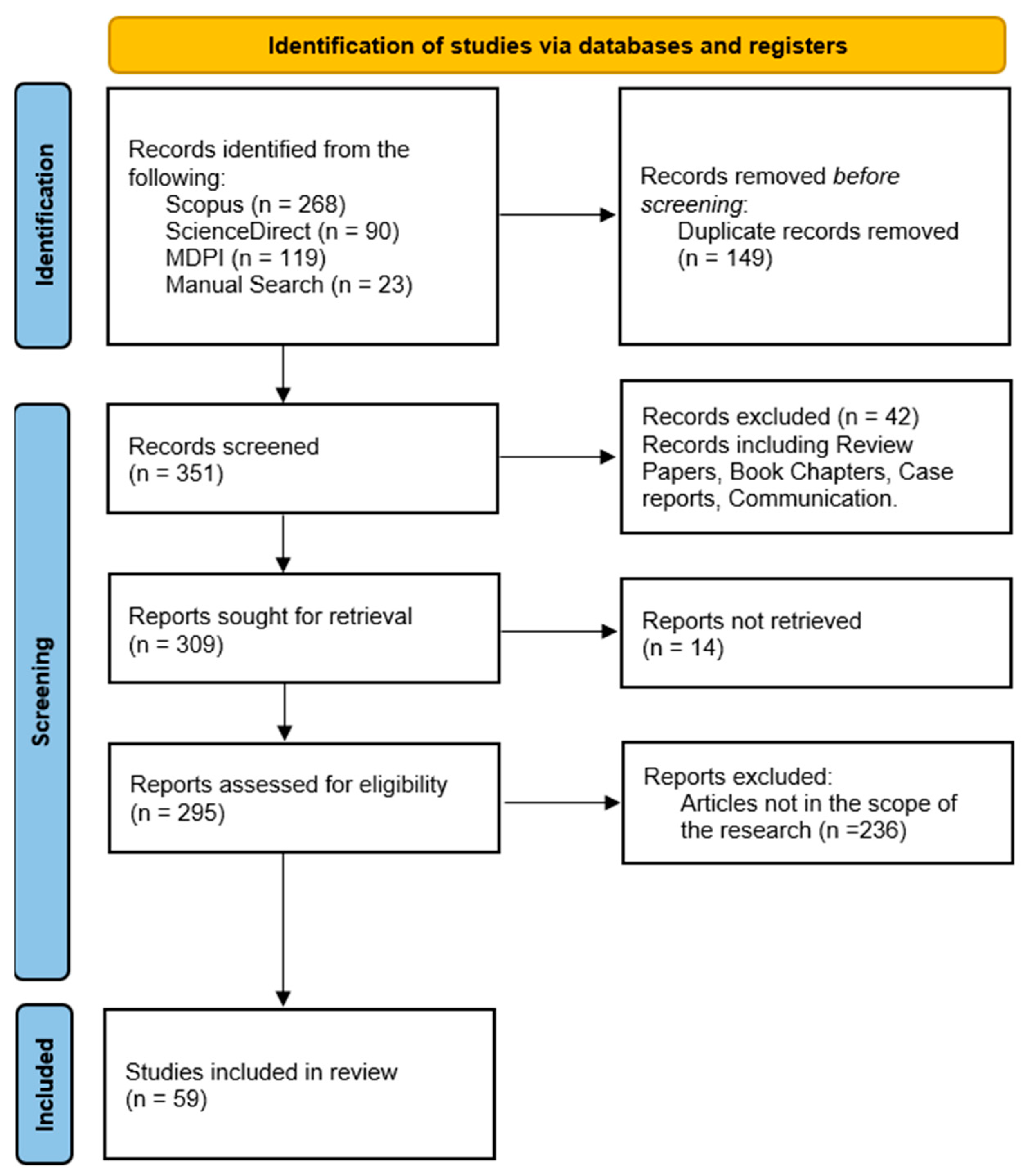

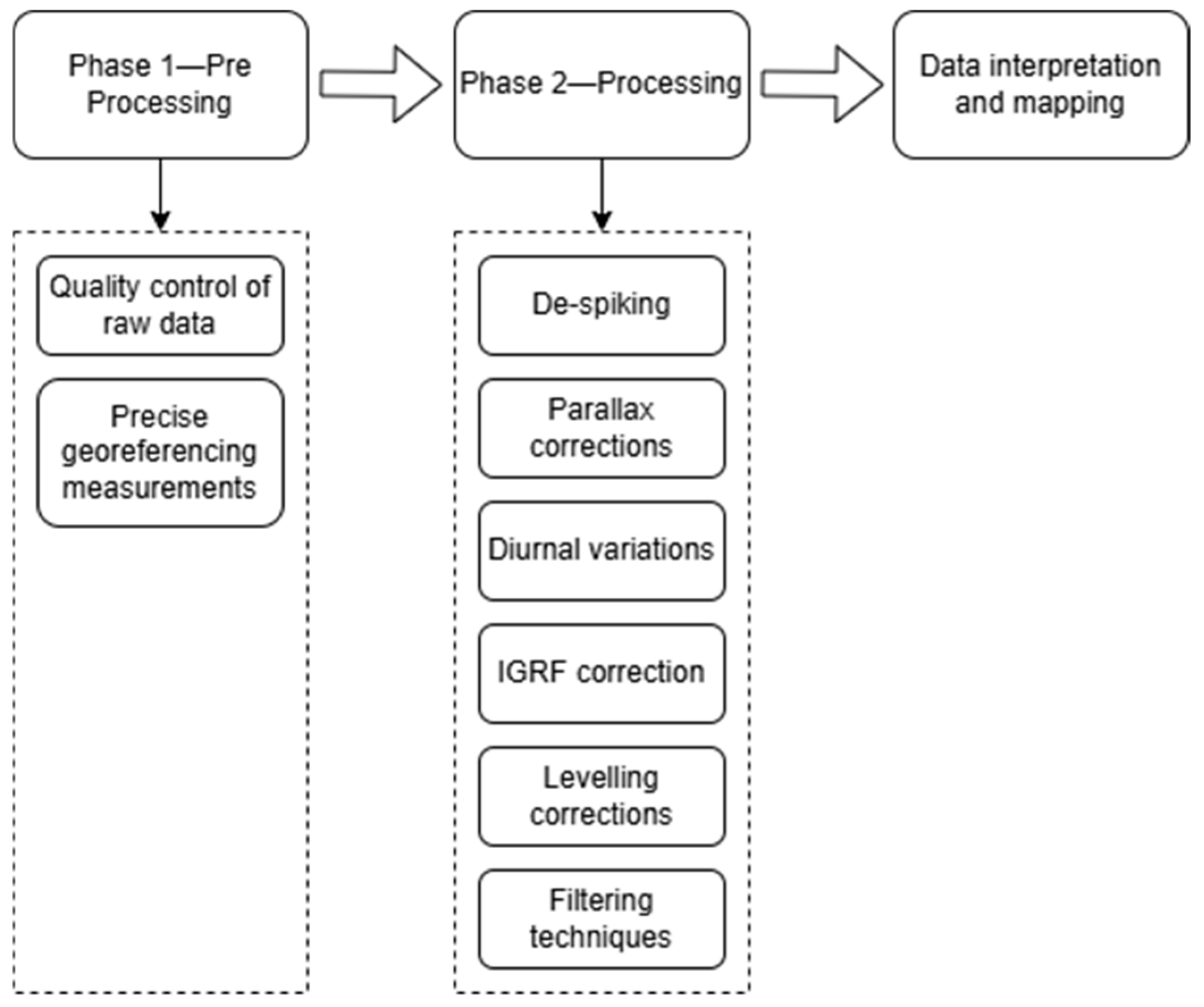
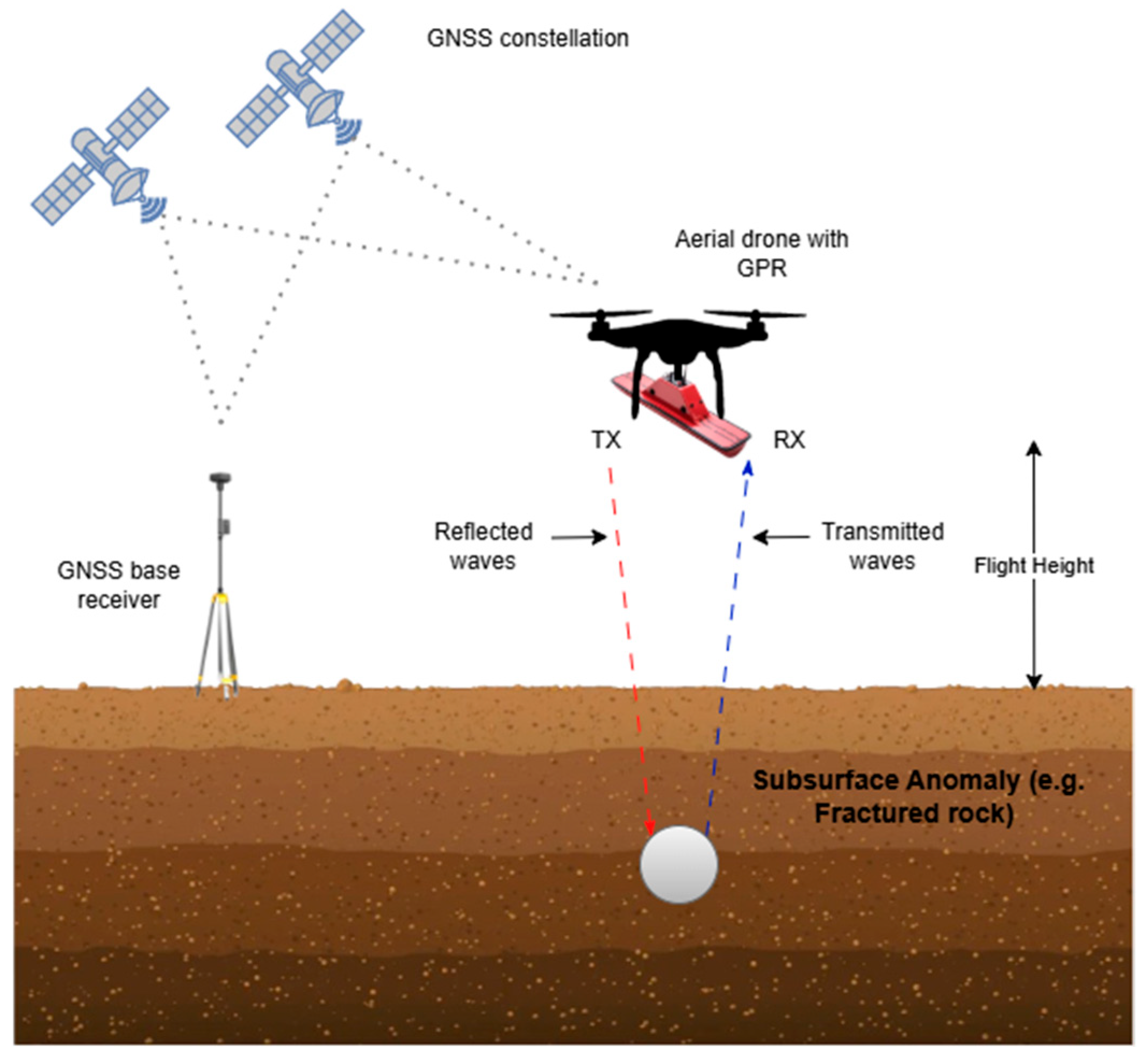
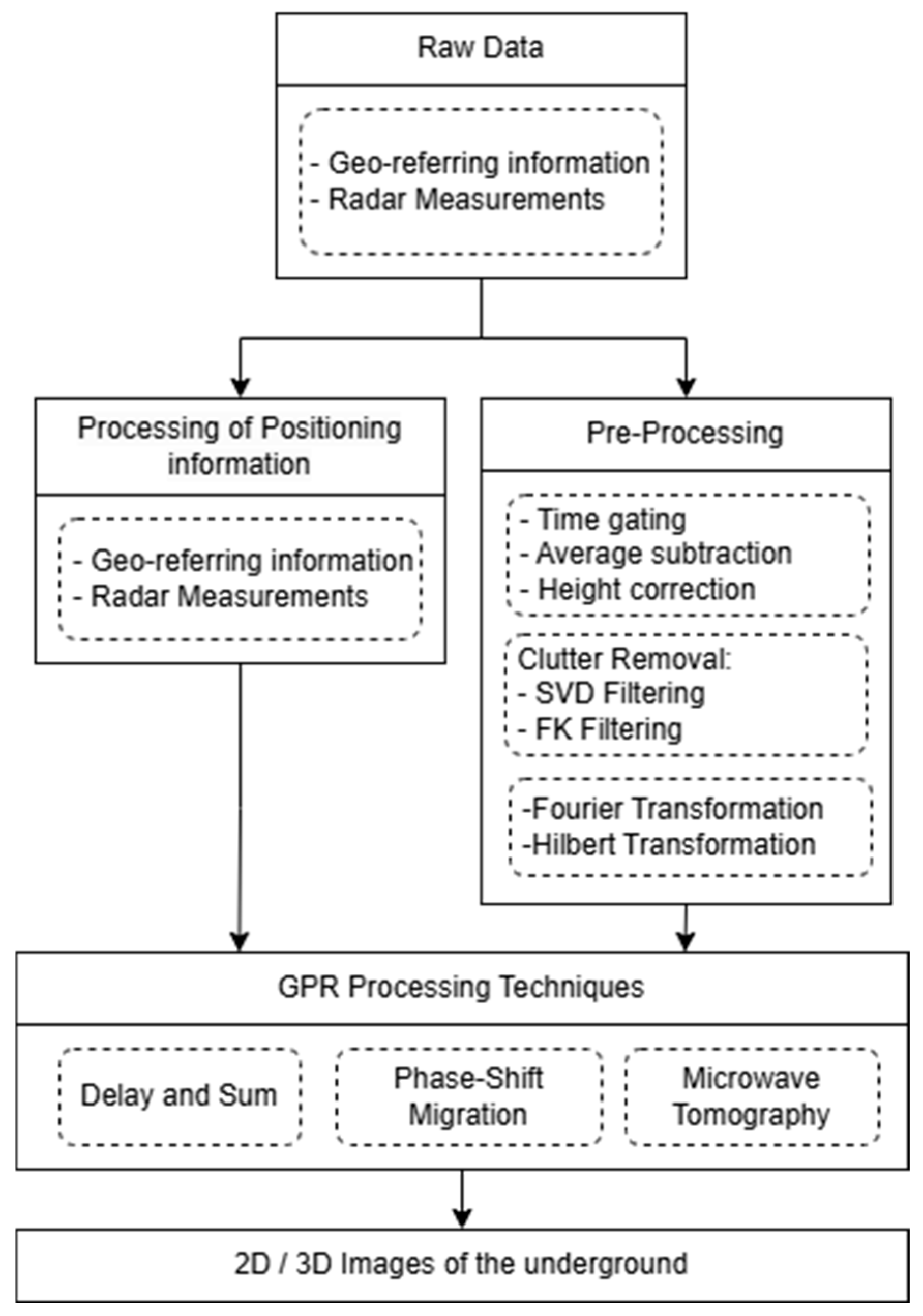
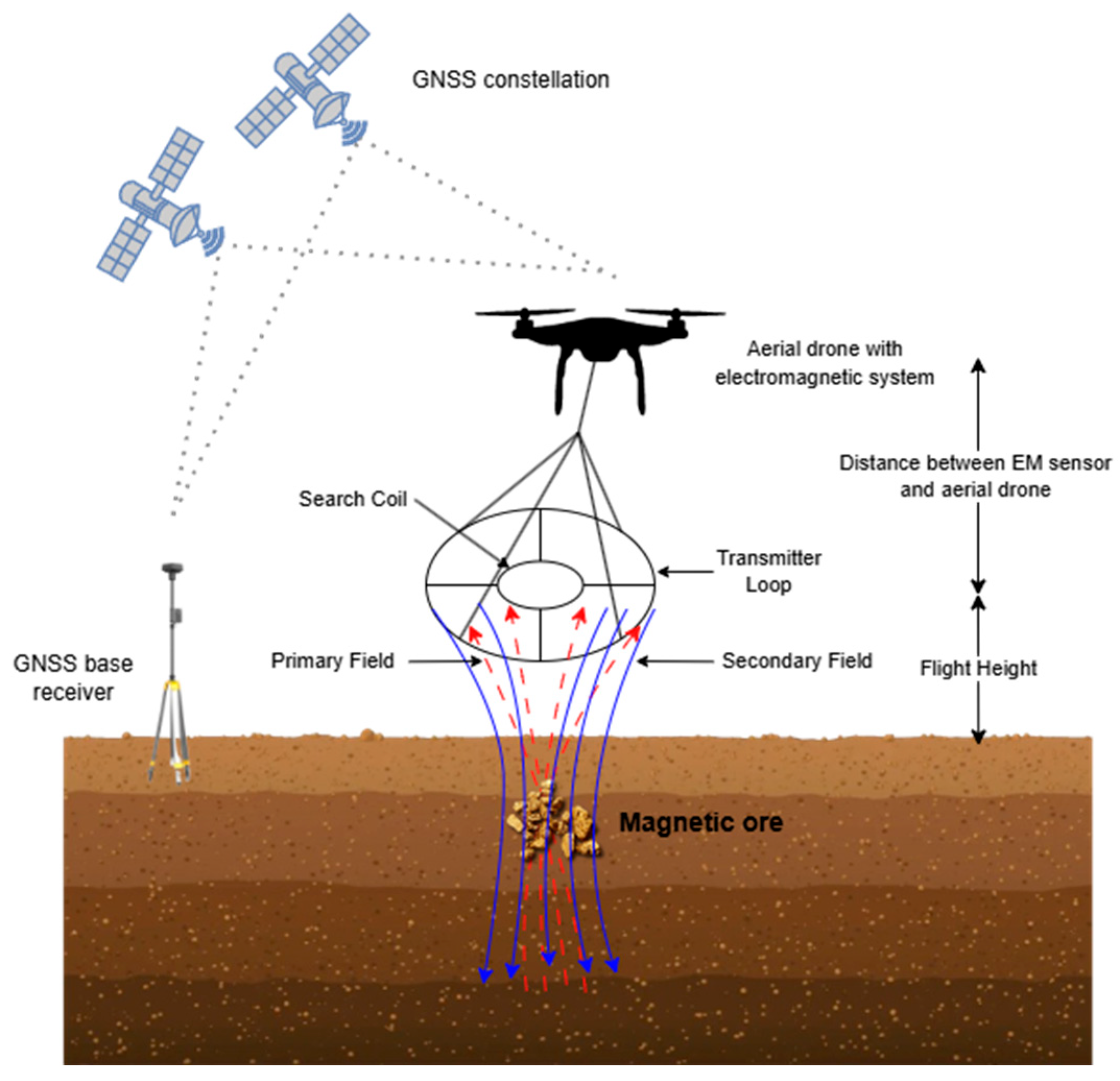
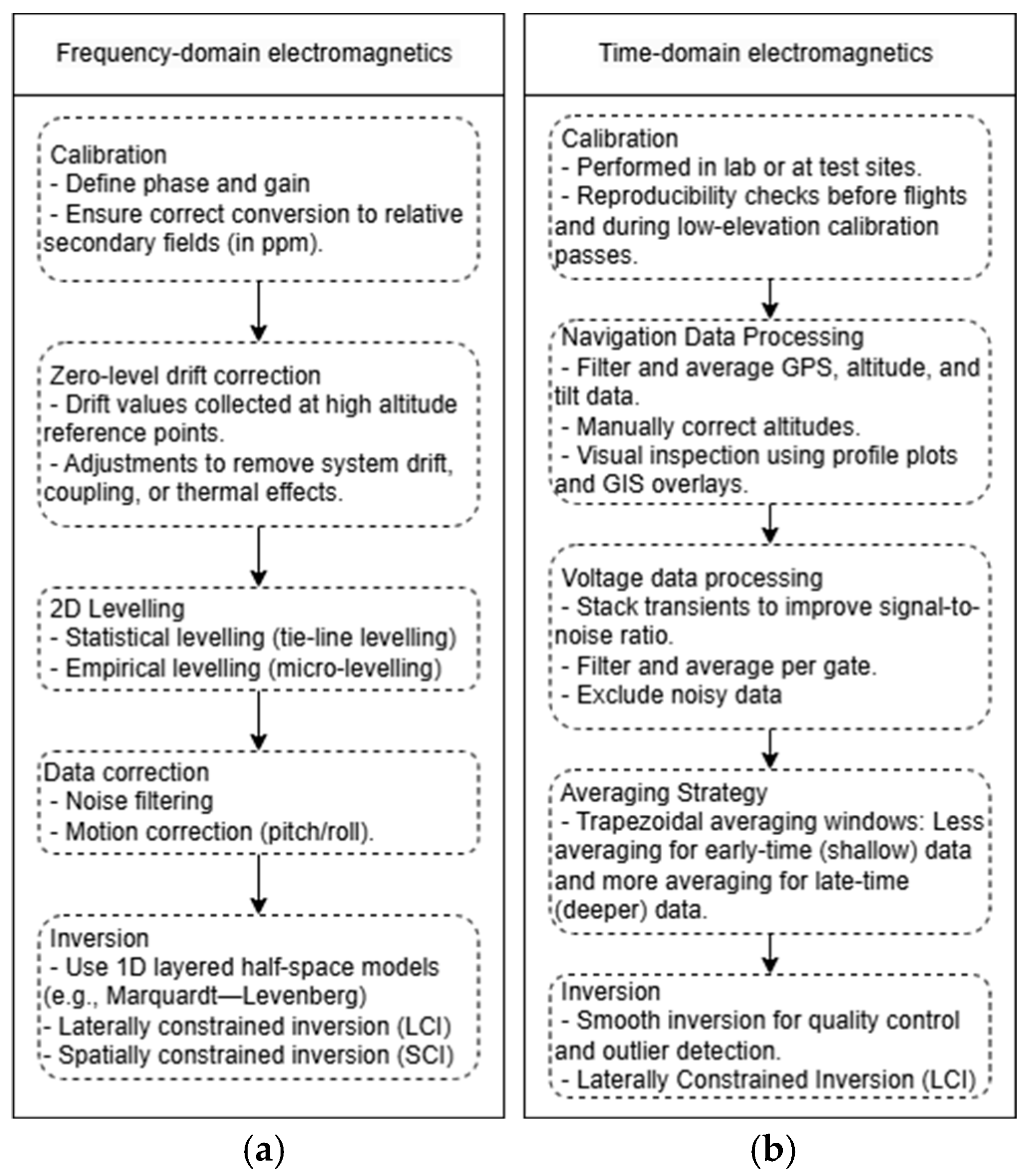
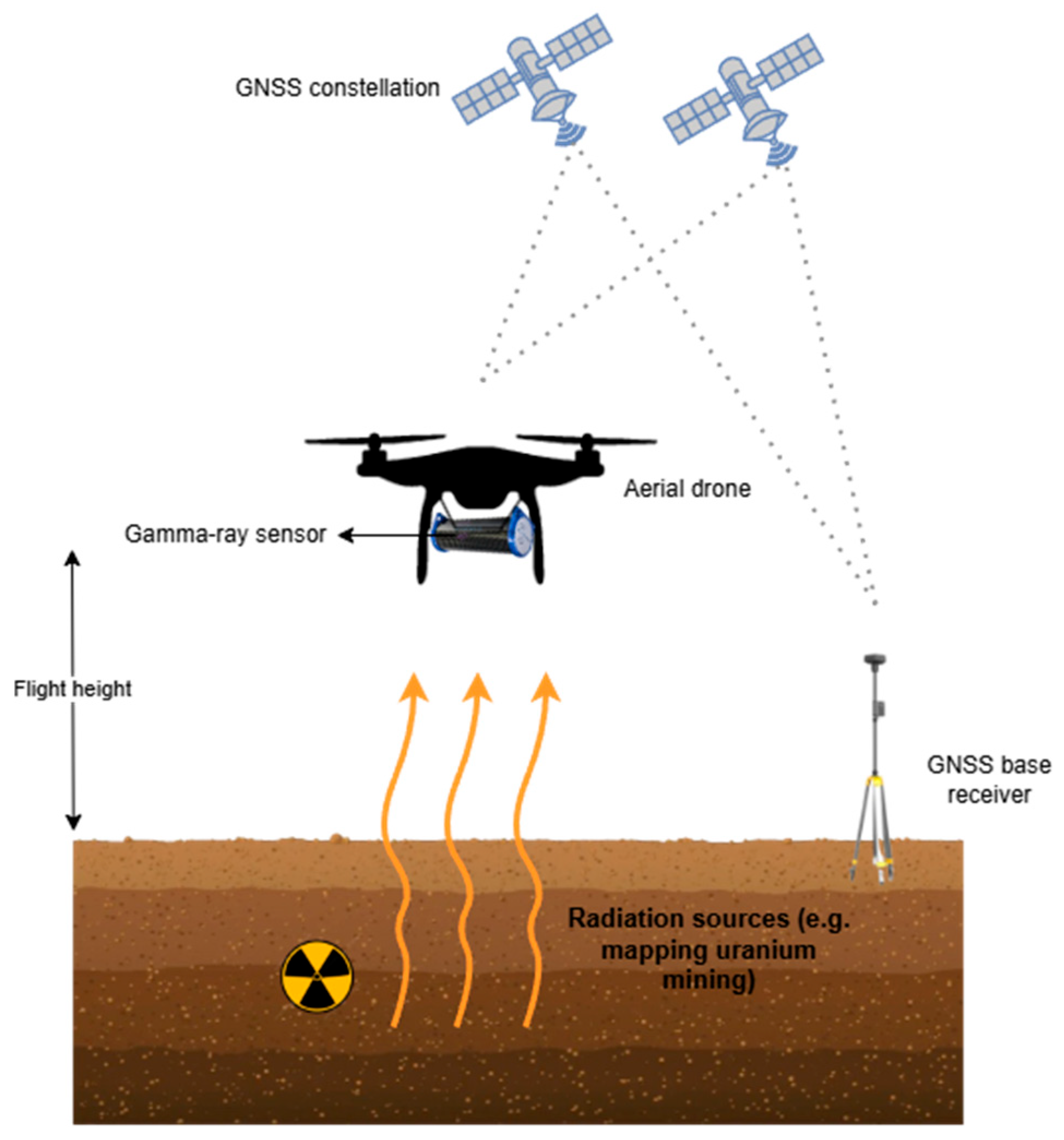
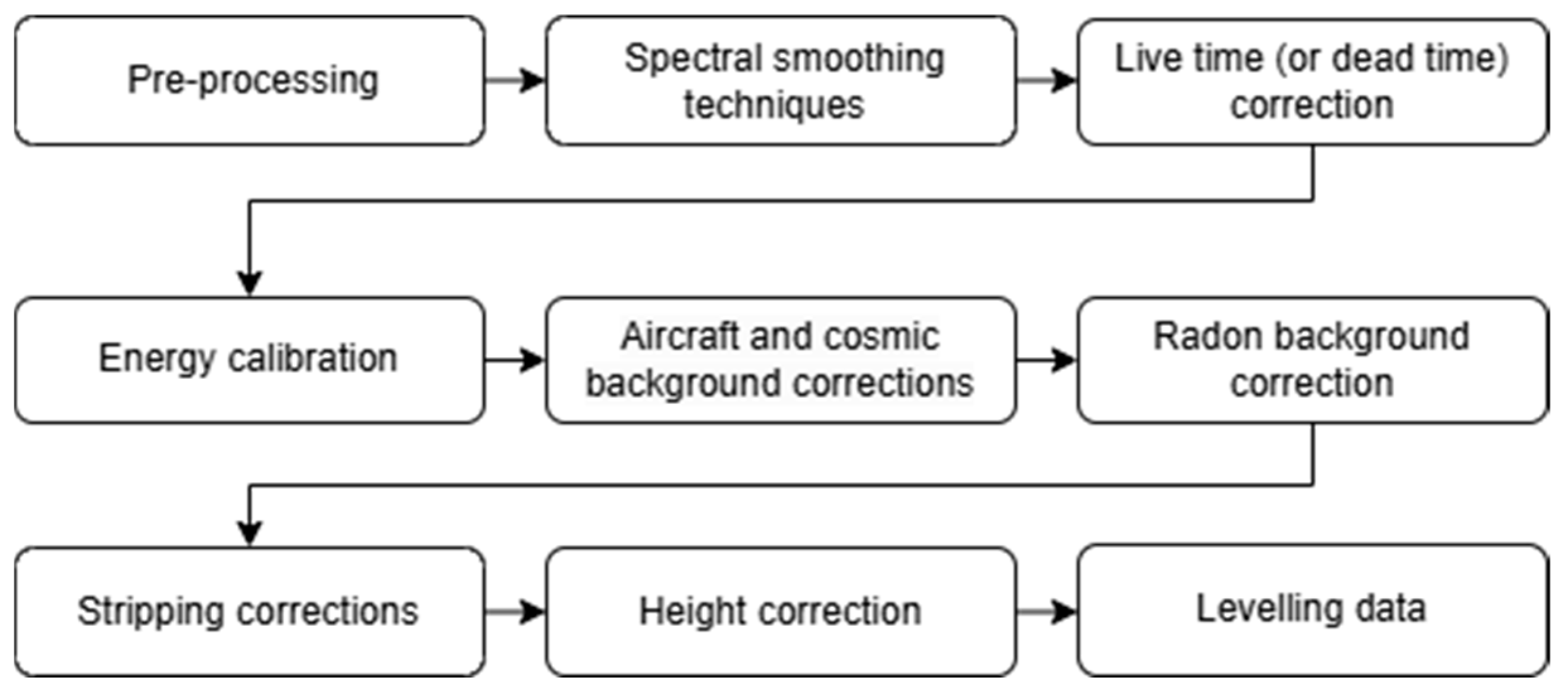
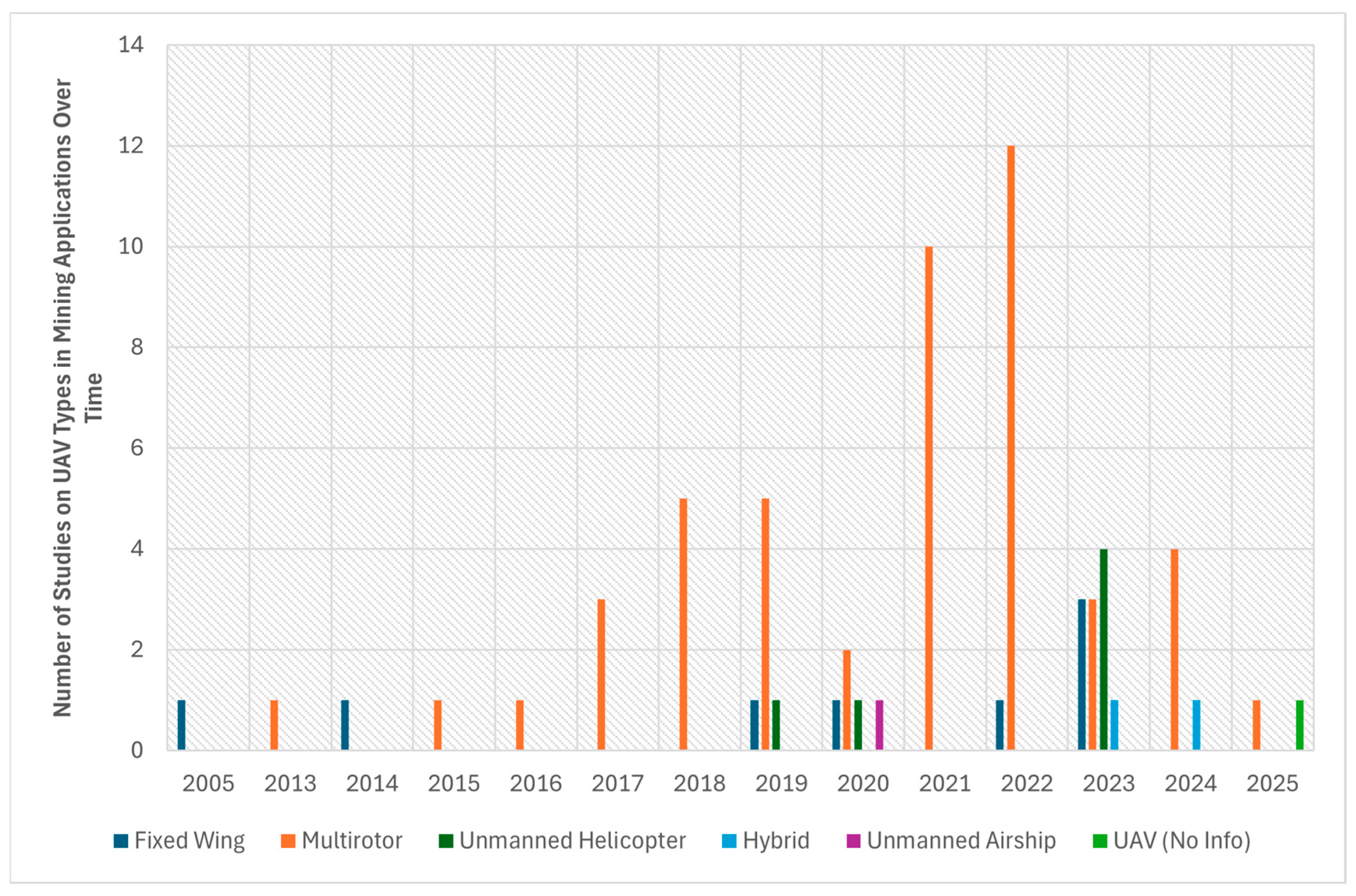

| Platform Type/UAV Name | UAV Model | Geophysical Sensor Type | Mining Phase | Advantages/Limitations |
|---|---|---|---|---|
| Fixed-wing WingtraOne [14] | 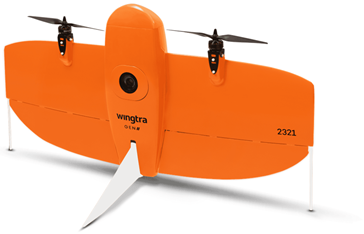 | Gamma-ray spectrometers | Exploration and restoration | Long endurance/needs runway and lacks hovering |
| Multirotor DJI M600 [15,16,17] | 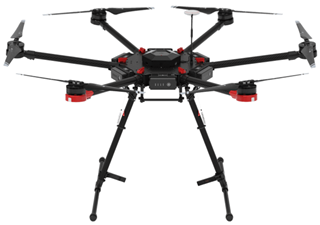 | Magnetometer, GPR system, and gamma-ray spectrometer | Exploration, extraction, and restoration | High stability and manoeuvrability/limited flight duration |
| Unmanned helicopter HE-190E [18] | 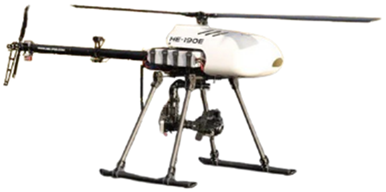 | Gamma-ray spectrometer | Exploration and restoration | High payload capacity and flight duration/mechanically complex and costlier |
| Hybrid fixed-wing CW30 [19] |  | Magnetometers | Exploration | Versatile/complex and heavier |
| Unmanned airship Prototype [20] | 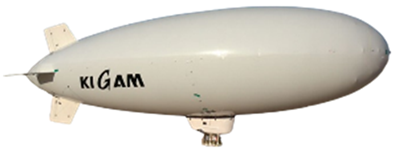 | Magnetometer | Exploration | Long endurance/limited control |
| Reference | Year | Platform Type | UAV Name/Model | Magnetic Sensor(s) | Aim of Study/Application |
|---|---|---|---|---|---|
| [64] | 2014 | Fixed-wing | CH3 (CAAA, Beijing, China) | Caesium-vapor (CS-VL) magnetic sensor | Geophysical survey over a mining area |
| [65] | 2005 | Fixed-wing | GeoRanger (Insitu Group, Inc., Bingen, WA, USA) | Caesium optical-pumping magnetometer (CS-3) from Scintrex | Offshore geophysical surveying |
| [66] | 2020 | Fixed-wing | Albatros VT2 | Three-axis fluxgate magnetometer | Geological and geophysical mapping of outcrop |
| [35] | 2019 | Fixed-wing | Radai Albatros VT | Three-axis fluxgate magnetometer | Characterise an outcrop of Fe-Ti-V deposit |
| [67] | 2023 | Fixed-wing | CH-3 FUAV (CH UAV Co. Ltd., in Beijing, China) | CS-3/CS-VL | Developed aeromagnetic systems for future geological survey and mineral exploration |
| [68] | 2022 | Fixed-wing | Albatros VT (Radai Ltd., Oulu, Finland) | Three-axis fluxgate magnetometer | Mineral exploration |
| [36] | 2013 | Multirotor | MD4-1000 (Microdrones GmbH, Siegen, Germany) | Three-axis fluxgate magnetometer | Detection of magnetic signatures after a landslide |
| [37] | 2016 | Multirotor | 3DR X8+ | Three-axis fluxgate magnetometer | Aeromagnetic survey for future prospective mining scenario |
| [38] | 2017 | Multirotor | DJI S1000 (SZ DJI Technology Co., Ltd., Shenzhen, China) | Overhauser magnetometer (GEM 19 GW) | Mineral exploration |
| [39] | 2017 | Multirotor | Sky Lance (UVAD Technologies Inc., Redcliff, AB, Canada) | Caesium-vapor magnetometer (Geometrics G-823A) | Mineral exploration (Zing) |
| [40] | 2018 | Multirotor | Heavyweight UAV | Quantum Overhauser magnetometer | Geophysical magnetic prospecting |
| [15] | 2019 | Multirotor | DJI M600 | Microfabricated Atomic Magnetometer | Detect and identify abandoned and unmarked oil and gas wells |
| [41] | 2021 | Multirotor | Sky Lance 6200 | Caesium-vapor magnetometer (Geometrics G-823A) | Gold exploration |
| [42] | 2021 | Multirotor | DJI M210 | MagArrow scalar magnetometer | Iron ore—mineral exploration |
| [43] | 2021 | Multirotor | FY680 (Tarot-RC, Shenzhen, China) | Magneto-Inductive sensor | Iron ore—mineral exploration |
| [35] | 2019 | Multirotor | Tho-R-PX8-12 | Fluxgate magnetometer (MagDrone R1) | Characterise an outcrop of Fe-Ti-V deposit |
| [44] | 2021 | Multirotor | DJI Matrice 600 Pro | Vapor magnetometer (GSMP-35U) | Mineral exploration |
| [45] | 2019 | Multirotor | DJI S900 | Vapor magnetometer (GSMP-35U) | Mineral exploration |
| [46] | 2017 | Multirotor | UAV-Mag™ system | Potassium-vapor magnetometer (GSMP-35A) | Mineral (Chromite) exploration |
| [47] | 2021 | Multirotor | UMT Cicada | Microfabricated Atomic Magnetometer | Detect and identify abandoned and unmarked oil and gas wells |
| [48] | 2023 | Multirotor | DJI M600 Pro | Proton magnetometer (GSM-19T) | Detect concealed magnetite ore bodies |
| [49] | 2024 | Multirotor | Ironman 650 (Tarot-RC, Shenzhen, China) | Two Magneto-Inductive sensors | Iron ore—mineral exploration |
| [50] | 2021 | Multirotor | DJI M210 | Rubidium QTFM from Quspin | Development of a magnetometer bird for mineral exploration/geological mapping |
| [51] | 2021 | Multirotor | Survey-grade aerial drone from DTU | Rubidium QTFM from Quspin | Mineral exploration |
| [52] | 2023 | Multirotor | DJI M600 Pro | Potassium-vapor magnetometer (GSMP-35U) | Geophysical survey for aquifer exploitation |
| [53] | 2022 | Multirotor | DJI M300 | Optical-pump magnetometer | Mineral exploration for potential archaeological site |
| [54] | 2024 | Multirotor | DJI S1000 | MagArrow scalar magnetometer | Mining archaeology |
| [55] | 2024 | Multirotor | CERBERUS UAV (ACCELIGENCE Ltd., Nicosia, Cyprus) | Vapor magnetometer (GSMP-35U) | Mineral exploration |
| [56] | 2023 | Multirotor | TERREMYS mono-sensor quadcopter | Bartington Mag03 | Map buried fault zones in granitic pluton |
| [57] | 2022 | Multirotor | DJI M600 Pro | Geometrics MagArrow | Detect conductive base metal sulphide targets in complex mining |
| [58] | 2022 | Multirotor | LUMS Q6 v1 | Bartington Mag03 | Mineral exploration—skarn mapping |
| [59] | 2022 | Multirotor | SkyLance 6200 | Caesium-vapor magnetometer (Geometrics G-823A) | Gold exploration |
| [60] | 2022 | Multirotor | SibGIS UAS | POS-family Proton Overhauser magnetometer | Uranium ore exploration |
| [61] | 2022 | Multirotor | Geoscan 401 Geophysics (Geoscan Ltd., Saint Petersburg, Russia) | Geoscan GeoShark—quantum rubidium magnetometer | Gold deposit exploration |
| [62] | 2019 | Multirotor | SibGIS UAS | Proton Overhauser magnetometer | Gold deposit exploration |
| [63] | 2018 | Multirotor | SibGIS UAS | POS-1LP Proton Overhauser magnetometer | Uranium ore exploration |
| [69] | 2020 | Unmanned helicopter | SU-H2M | Potassium magnetometer (GSMP-35U) and three-axis fluxgate magnetometer (TFM100-G2) | Magnetite deposit—mineral exploration |
| [67] | 2023 | Unmanned helicopter | WH-110A MUH | CS-VL magnetometer | Developed aeromagnetic systems for future geological survey and mineral exploration |
| [70] | 2023 | Unmanned helicopter | DY-115 (Jiangsu East Wing General Aviation Technology Co., Ltd., Changzhou, China) | CS-3 magnetometer and TFM100-G2 fluxgate magnetometer | Resource exploration in the Bayan Obo mining area |
| [19] | 2023 | Hybrid | CW30 hybrid fixed-wing (IGGE, Langfang, China) | CS-VL magnetometer (SCINTREX) and a fluxgate | Mineral exploration (porphyry copper–gold deposit) |
| [20] | 2020 | Unmanned airship | Unmanned airship | Caesium magnetometer (G-824A) | Magnetic exploration |
| References | Magnetometer Used | Resolution (nT) | Sensitivity | Sample Rate | Heading Error (nT) |
|---|---|---|---|---|---|
| [64,67] | CS-VL magnetic sensor | - | 0.0006 nT √Hz | - | ±0.2 |
| [65] | CS-3 magnetometer | - | 0.001 nT @1 Hz | 1 KHz | - |
| [35,66,68] | Three-axis fluxgate magnetometer | 0.5 | - | 1 KHz | - |
| [35] | Fluxgate magnetometer (MagDrone R1) | >0.15 nT | - | - | - |
| [36] | Three-axis fluxgate magnetometer | <1 | 0.07 nT @10 Hz | 1–125 Hz | - |
| [37] | Three-axis fluxgate magnetometer | <0.5 | - | - | - |
| [38] | Overhauser magnetometer (GEM 19 GW) | 0.01 | 0.022 nT @ 1 Hz | 5 Hz | ±0.1 |
| [39,41,59] | Caesium-vapor magnetometer (Geometrics G-823A) | - | 0.004 nT/√Hz | 5 Hz | ±0.15 |
| [40] | Quantum Overhauser magnetometer | 0.001 | - | 8 Hz | - |
| [15] | Microfabricated Atomic Magnetometer (MFAM) | 0.001 | - | - | - |
| [42,54,57] | MagArrow scalar magnetometer | - | 0.005 nT/√Hz | 1000 Hz | ±5 |
| [43] | Magneto-Inductive sensor | 2.7 | 0.004 nT/√Hz | - | - |
| [44,45,52,55,69] | Vapor magnetometer (GSMP-35U) | 0.0001 nT | 0.0002 nT @ 1 Hz | 1, 2, 5, 10, 20 Hz | ±0.05 |
| [46] | Potassium-vapor magnetometer (GSMP-35A) | 0.0001 | 0.0002 nT/√Hz | 1, 5, 10, 20 Hz | ±0.05 |
| [47] | Geometrics MFAM | - | 0.005 nT/√Hz | 1 kHz | - |
| [48] | Proton magnetometer (GSM-19T) | 0.01 nT | 0.15 nT @ 1 Hz | - | ±0.2 |
| [49] | Magneto-Inductive sensor | 2 nT | - | 40 Hz | - |
| [50,51] | Rubidium QTFM magnetometer | - | 0.001 nT/√Hz | - | ±0.15 |
| [53] | Optical-pump magnetometer | 0.0001 nT | 0.02 nT/√Hz | - | - |
| [19,67] | SCINTREX CS-3 magnetometer | - | 0.0006 nT/√Hz | - | ±0.2 |
| [20] | Caesium magnetometer (G-824A) | 0.01 nT | 500 fT/√Hz | - | ±0.15 |
| [56,58] | Bartington MC03 | 1 nT | - | 25 Hz | - |
| [70] | CS-3 magnetometer | 2.5 nT | 0.0006 nT/√Hz | - | ±0.2 nT |
| [70] | TFM100-G2 magnetometer | - | 100 µV/nT | - | - |
| [60] | POS-family Proton Overhauser magnetometer | - | 0.08 nT/√Hz | 2 Hz | ±0.5 nT |
| [61] | Geoscan GeoShark—quantum rubidium magnetometer | - | 1 pT/√Hz | 1000 Hz | <0.3 nT |
| [62] | Proton Overhauser magnetometer | - | - | 2–3 Hz | - |
| [63] | POS-1LP (Proton Overhauser) | - | 0.03–0.3 nT√Hz | 1–3 Hz | - |
| Reference | Year | Platform Type | UAV Name/Model | GRS Sensor(s) | Aim of Study/Application |
|---|---|---|---|---|---|
| [16] | 2021 | Multirotor | DJI M600 | COBRA Plug-in SE-150 (Radarteam Sweden AB, Boden, Sweden) | Characterisation of quarry excavation areas |
| Reference | Dynamic Range | Maximum Depth | Bandwidth (BW) | Central Frequency (CF) |
|---|---|---|---|---|
| [16] | 192 db | 120 m | 260 MHz | 124 MHz |
| Reference | Year | Platform Type | UAV Name/Model | EM Sensor(s) | Aim of Study/Application |
|---|---|---|---|---|---|
| [81] | 2021 | Multirotor | SibGIS UAS | UAV TEM (includes an induction sensor, a measuring unit (MARS), and a recorder) | Mineral exploration (uranium region) |
| [82,83] | 2022 | Multirotor | SibGIS | UAV TEM (includes an induction sensor (PDI-50), a measuring unit (Mars 4.0), and a mini computer recorder) | Mineral exploration (uranium region) |
| [60] | 2022 | Multirotor | SibGIS UAS | UAV TEM (includes a loop-analogue induction sensor, a measuring unit, a mini onboard recorder, and a ground-based Tx line) | Mineral exploration (sandstone-type uranium, blind deposit detection) |
| [84] | 2024 | Hybrid UAV | - | Electromagnetic System “Louhi” (Radai Ltd., Oulu, Finland) | Mineral exploration |
| Reference | Year | Platform Type | UAV Name/Model | GRS Sensor(s) | Aim of Study/Application |
|---|---|---|---|---|---|
| [14] | 2023 | Fixed-wing | WingtraOne (Wingtra AG, Zürich, Switzerland) | Caesium Iodide (CsI) scintillator and Cadmium Zinc Telluride (CZT) semiconductor | Mapping uranium mine site |
| [88] | 2023 | Fixed-wing | CH-3 | Ugrs10—thallium-doped sodium iodide—NaI (Tl) 4.2 L | Radioactive mineral exploration |
| [17] | 2018 | Multirotor | DJI M600 | MS 1000—1.0L NaI | Mapping mine tailings |
| [87,89] | 2022 | Multirotor | DUB-GEM UAV | Medusa—Cerium Bromide (CeBr3) scintillation detector; innoRIID—twin detector (NaI, CeBr3) | Mapping uranium mining |
| [90] | 2015 | Multirotor | AARM-X8 | CZT coplanar-grid Kromek™ GR1 detector | Radiological characterisation of a single legacy mining site |
| [91] | 2018 | Multirotor | Hexacopter-type Kingfisher (Robodrone Industries s.r.o., Brno, Czech Republic) | Georadis D230A | Uranium exploration |
| [86] | 2021 | Multirotor | SibGIS UAS | CsI(Na) 30 × 150mm crystal; CsI(Tl) crystal of 40 × 80 mm | Uranium exploration |
| [92] | 2024 | Multirotor | DUB—GEM UAV | Medusa—CeBr3 | Mineral exploration in low-grade ore heap |
| [93] | 2020 | Multirotor | SibGIS UAS | 2 CsI(Tl) 8 × 100 mm | Gold exploration |
| [94] | 2020 | Multirotor | DJI M100 | SIGMA-50—CsI(Tl) scintillator | Mapping a Cu/Fe mine site |
| [95] | 2025 | Multirotor | F1800 | NaI crystal 51 × 102 × 406 mm | Mapping rare earth deposit |
| [60] | 2022 | Multirotor | SibGIS UAS | CsI(Tl) 63 × 63 mm crystal | Prospecting blind uranium ore deposits (U, Th) |
| [62] | 2019 | Multirotor | SibGIS UAS | CsI(Tl) 63 × 63 mm crystal | Greenfield gold exploration |
| [63] | 2018 | Multirotor | SibGIS UAS | CsI(Tl)/NaI(Tl) 80 × 80 mm | Uranium exploration |
| [18] | 2019 | Unmanned helicopter | HE-190E | MS-1000—1.0 L NaI | Mapping mine tailings |
| [96] | 2023 | Unmanned helicopter | Z100 (Tianyu Aviation Technology Co., Ltd., Langfang, China) | Gamma-ray spectrometry—4 L NaI(Tl) crystal | Mapping uranium tailings |
| [88] | 2023 | Unmanned helicopter | SY-120H | Ugrs10—NaI(Tl) 4.2 L | Radioactive mineral exploration |
| [97] | 2025 | UAV (no information) | - | Medusa (MS350)—350 mL Csl | Metapegmatite exploration |
| References | Gamma-Ray Spectrometer Used | Crystal Type | Crystal Dimensions (Inches) | Crystal Volume (cm3) | Number of Spectral Bands | Radionuclide Analysis |
|---|---|---|---|---|---|---|
| [14] | Hamamatsu—C12137-01 | CsI (TI) | 1.5 × 1.5 | 0.0036 | - | - |
| [14,90] | Kromek GR-1 CZT | CZT | - | 0.001 | - | - |
| [17,18] | MS-1000 | NaI | 3 × 9 | 1000 | - | 40K, 238U, 232Th and 137Cs |
| [87,89,92] | MS-700 | Cebr3 | 3 × 6 | 700 | 2048 | 40K, 238U, 232Th and 137Cs |
| [87,89] | innoRIID | NaI | 3 × 3 | 350 | 1024 | - |
| [87,89] | innoRIID | Cebr | 2 × 2 | 100 | 1024 | - |
| [89] | MS-700 | CsI | 3 × 6 | 700 | 2048 | 40K, 238U, 232Th and 137Cs |
| [91] | D230A by Georadis | BGO | 2 × 2 | 0.103 | 1024 | - |
| [86] | Gamma-ray spectrometer | CsI (TI) | 0.3 × 3.93 | 0.0065 | - | - |
| [86] | Gamma-ray spectrometer | CsI (TI) | 1.6 × 3.15 | 0.1 | - | - |
| [93] | Gamma—radiometer | CsI (TI) | 0.3 × 3.93 | - | - | - |
| [96] | GRS (Chengdu University of Technology) | NaI (TI) | - | 4 | 1024 | - |
| [97] | MS-350 | CsI | 3 × 3 | 300 | 1024 | 40K, 238U, 232Th and 137Cs |
| [94] | SIGMA 50 | CsI (TI) | 1 × 2 | 32.8 | 4096 | - |
| [95] | XTG-3000 A | NaI | 2 × 4 × 16 | 850 | 1024 | 40K, 238U, 232Th |
| [88] | UGRS-10 | NaI | 4 × 4 × 6.5 | 4200 | 256/1024 | 40K, 238U, 232Th |
| [60] | SibGIS UAS (custom system) | CsI (Tl) | 2.5 × 2.5 | 196.3 | 8096 | 40K, 238U, 232Th |
| [62] | - | CsI (Tl) | 2.5 × 2.5 | 196.3 | 2000 | 40K, 238U, 232Th |
| [63] | - | CsI (Tl) or NaI (TI) | 3.15 × 3.15 | 402.1 | - | 40K, 238U (226Ra), 232Th, 137Cs |
Disclaimer/Publisher’s Note: The statements, opinions and data contained in all publications are solely those of the individual author(s) and contributor(s) and not of MDPI and/or the editor(s). MDPI and/or the editor(s) disclaim responsibility for any injury to people or property resulting from any ideas, methods, instructions or products referred to in the content. |
© 2025 by the authors. Licensee MDPI, Basel, Switzerland. This article is an open access article distributed under the terms and conditions of the Creative Commons Attribution (CC BY) license (https://creativecommons.org/licenses/by/4.0/).
Share and Cite
Perikleous, D.; Margariti, K.; Velanas, P.; Blazquez, C.S.; Gonzalez-Aguilera, D. Aerial Drones for Geophysical Prospection in Mining: A Review. Drones 2025, 9, 383. https://doi.org/10.3390/drones9050383
Perikleous D, Margariti K, Velanas P, Blazquez CS, Gonzalez-Aguilera D. Aerial Drones for Geophysical Prospection in Mining: A Review. Drones. 2025; 9(5):383. https://doi.org/10.3390/drones9050383
Chicago/Turabian StylePerikleous, Dimitris, Katerina Margariti, Pantelis Velanas, Cristina Saez Blazquez, and Diego Gonzalez-Aguilera. 2025. "Aerial Drones for Geophysical Prospection in Mining: A Review" Drones 9, no. 5: 383. https://doi.org/10.3390/drones9050383
APA StylePerikleous, D., Margariti, K., Velanas, P., Blazquez, C. S., & Gonzalez-Aguilera, D. (2025). Aerial Drones for Geophysical Prospection in Mining: A Review. Drones, 9(5), 383. https://doi.org/10.3390/drones9050383









